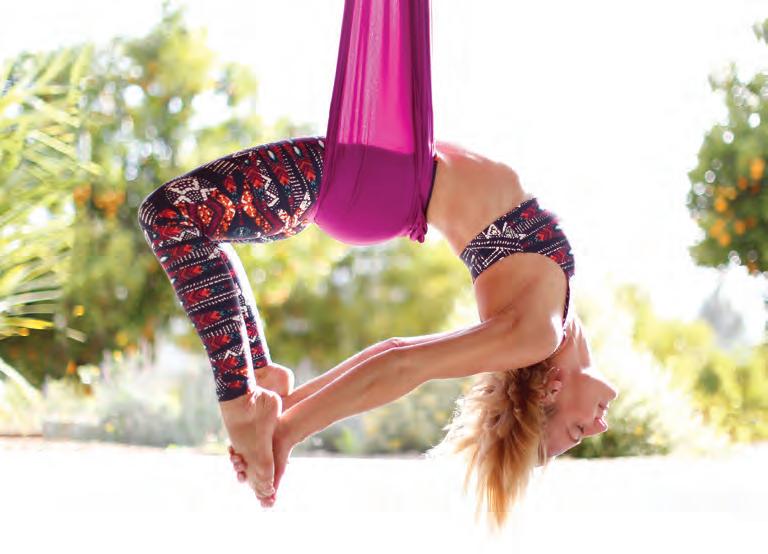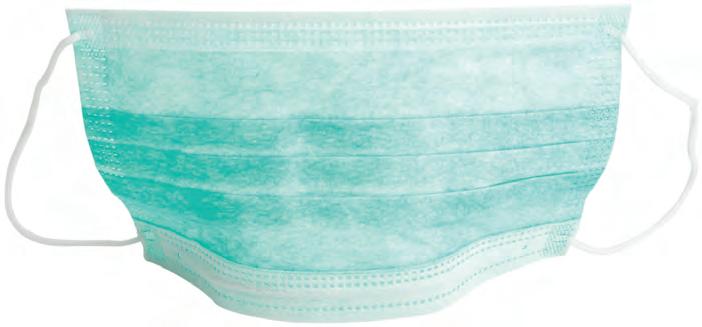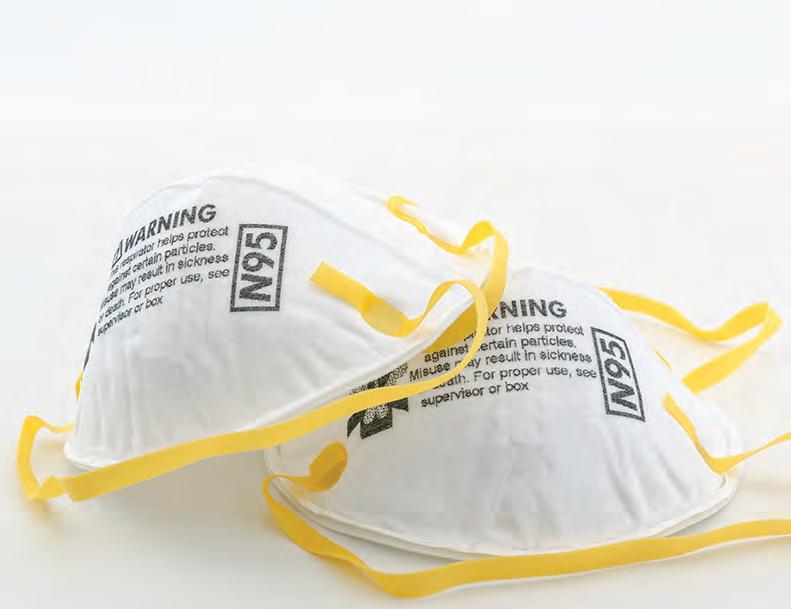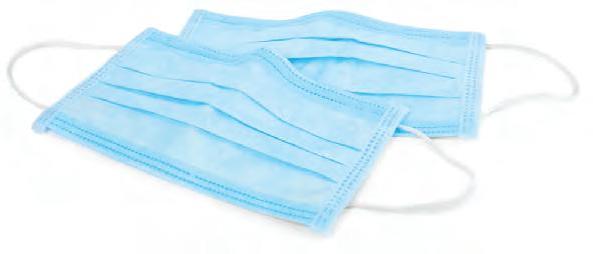
15 minute read
NEWS
Who’s on First NEWS COVID-19 fit Local fitness studios offering virtual classes
by Kateri Wozny
Fitness studios throughout Ventura County may be temporarily closed, but that isn’t stopping them from keeping people’s minds alert and heart beats up virtually! Whether you’re a beginner or advanced, here is a list of online classes to try at home.
The Aerial Studio (Ventura) www.theaerialstudio.net or www.airealyoga.com
Pre-recorded Gentle, Restorative, Power, Slow Flow, beginner and advanced aerial yoga using a soft hammock attached to a rig.
Egyptian Dance with Zahra (Ventura) www.zahraraqs.com
Level I and Level II traditional and folkloric dance styles of Egypt, also known as Raqs Sharqi, via Skype.
“Not only do they get to learn a really fun and sensual dance, but they get to learn about the culture of Egypt,” said Zahra Sami, owner.
Prices: $144 for 12 week sessions.
Elements of Movement Studio (Ojai) Belinda Hill at info@elementsojai.com
Conditioning, strength and mobility classes that support strong aerial movement via Zoom. Floor-based practices will be implemented when the studio reopens.
Prices: $10 for a single class, $32 for a four classes, $32 for eight classes and $56 for 12 classes. with kickboxing, yoga and the Alexander Technique via Zoom.
“This class is robust and brings people together in a safe setting to activate the mind, body and spirit,” said Marcus Kettles, co-owner.
Prices: $5 for a single class or $9 who can contribute more, $99 for unlimited classes.
FitZone (Ventura) www.fitzoneventura.com. On Facebook, ask to join the Facebook “Zoners: Community Page.”
Barre, kickboxing, Tabata (high-intensity interval training that lasts four minutes), band work and games for kids such as fitness bingo via Facebook Live. Kits with a band and Pilates ball can be delivered to customer’s residences.
“Joining this community keeps people connected not just through exercise but friendships as well,” said Molly Hill, owner.
Pre-recorded classes with wellness therapy, meditation, breathing techniques, Restorative, Gentle, power fitness and strength building.
Prices: $39 for the New Student Intro Month Pass of unlimited yoga. Use code: stayhome
Hamsa Studio (Ojai) www.hamsaojai.com
Dance cardio, belly dance, Bollywood, barre, contemporary dance, Nia Technique, five rhythms and yoga via Zoom. There is also a kids’ ribbon dance.
Prices: $5 for new client drop-in, $15 for regular drop-in, $60 for 5 classes, $100 for 10 classes, $120 a month for unlimited access. via Zoom. The Health is Wealth Challenge includes a clean eating program and 30-day access to virtual programming.
Prices: $39 for unlimited all-access pass for 30 days, $297 for the Health is Wealth Challenge.
Lokah Yoga (Moorpark) www.lokahyogaspace.com or email kelly@lokahyogaspace.com
Lokah Yoga offers core, Slow Flow, Gentle, Choga (chair yoga), Yang/Yin, Piyo and meditation via Zoom, Facebook Live and YouTube. Kids and teen classes will also be added. “Yoga is important to slow ourselves down and connect to one self at breath; it helps with the anxiety and depression,” said Kelly Kennedy, owner.
Prices: Free
The Pilates Studio (Newbury Park) www.thestudionp.com
Classical Pilates, Reformer on the mat, flow, bodywork and stretch via Zoom.
“Coming together and talking to each other in our own homes has been an amazing experience,” said Colleen Ballew, owner.
Prices: $39, $69 or $99 for 30 days depending on affordability, $19 for unlimited recorded sessions.
SoulBody Yoga (Moorpark) www.soulbodyyoga.com
Flow, Yin, Hot, Therapeutic, Hatha, Chakra meditation and belly dance via Zoom.
Prices: Free. Donations are welcomed.
Studio 8 Fitness (Ventura) www.studio8fitness.com
Pop Pilates, PIIT28 (high-intensity interval training class combined with Pilates), Booty and the Beat (barre meets functional fitness choreographed to music), yoga and GROOV3 dance (hip-hop dance class) via Facebook Live.
Prices: $15 a week for unlimited classes.

about what’s happening,” said Kathy Lopez, owner. “It’s super comfortable and you can use pillows and blankets in the house.”
Sun Kissed Yoga (Camarillo) www.sunkissedyogavc.com
All levels of Vinyasa Flow, Yin/ Yang, Yin, Stretch, Slow Flow, and guided meditation via Zoom.
“We’re all going through a stressful time and the classes help people stay grounded and connected to some kind of a normal life,” said Michael Tang, co-owner.
Prices: $5 for a single class, $25 for one week unlimited, $40 for two weeks unlimited. Classes are free for medical professionals.
Pilates at all levels and body rolling via Zoom.
V-Fit Studio (Ventura) www.vfitstudio.com
Barre, Pilates mat class, Flow, Restorative, strength and cardio, and cardio and core via Zoom.
“This is an important time to take care of your health and working out reduces stress, improves the immune system and creates normalcy in your life,” said Kathy Lopez, co-owner.
Barre classes in Floor, Length and Strength, core work, yoga and Piyo via Zoom.
Prices: $20 for a single class, $55 for five classes and $150 membership for unlimited month-to-month livestream access.
Ventura Danzar Fitness & Zumba Fitness (Ventura) www.venturazumba.com
Cardio hip-hop, yoga, Zumba, Pop Pilates and barre via Periscope. There is also Danzar Live Gold for senior citizens.
“I’ve had ton of people tell me it gets them through the day and moving around relieves stress and anxiety,” said Ionia Kershaw, owner.
Prices: $30 for two weeks.
Yoga Casita (Santa Paula) Facebook and YouTube at Yoga Casita
Karma, Power, Yogalates, all levels, Slow and Gentle Flows, and mobility via Facebook Live and YouTube.
“We go live at 9 a.m. and offer a variety of routines so you can have something different every day,” said Natalie Huss, co-owner.
Prices: Free.
The Yoga Channel (Oxnard) www.theyogachannel.net
Kundalini, Strong, Gentle, Mindful, Stretch, Restorative, Flow, Yin, Chakra and breathing techniques via Zoom.
“Yoga can help cultivate calmness in the chaos,” Aurora Heinemann, steward.
Prices: $13 for a single class. Class passes that expire in 30 days include $36 for three, $44 for five for new students, $66 for six, $89 for nine and $108 for 12.
Yoga Jones (Ventura) www.yogajones.com
Ashtanga, Hatha Flow with spine, Vinyasa Flow, Yin and meditation via Zoom.
“With yoga, it’s more than being physical, it’s a mind-body element that helps you relax,” said Tracy Marcynzsyn, owner.
Straight talk on masks

CMH medical officer explains mask options
by Kimberly Rivers kimberly@vcreporter.com
As the pandemic reached Ventura County, the public was told they didn’t need to wear masks. That stance softened on April 2, when Dr. Robert Levin, health officer with Ventura County Public Health (VCPH), suggested that the public can help stop the spread by wearing a cloth mask when out of their homes for essential activities.
“There is growing evidence that people can have COVID-19 without any symptoms and that they can pass it to others at this stage,” said Levin in a written statement. “Many people wear masks thinking it will protect them from a virus, and in certain cases it may. That may also be true for COVID-19 especially if accompanied by good hand hygiene and social distancing, but now there may be a better reason to wear a mask; it will decrease the chance of you spreading it to someone else if you have the infection asymptomatically.”
Levin’s statement specified that face coverings “should not be hospital grade . . . because there is a shortage and our health professionals need them. Masks should be homemade.”
Dr. Stanley Frochtzwajg, chief medical officer at Community Memorial Health System (CMH), agrees that the spread can be slowed

by the public wearing cloth masks — but he stressed they should be only worn for a “brief period,” and he warned of a “false sense of security.”
“There are multiple layers to this,” said Frochtzwajg, speaking with the VCReporter on April 3. He said we have now been “told in California to wear masks all the time. The other part about the COVID-19 pandemic is that it is ever changing. This is the most dynamic environment . . . What we consider a protocol one day is thrown out the window the next week . . . We are learning as we are going forward.”
N95 and surgical masks
According to the FDA, an N95 mask or respirator (both words are used interchangeably and describe the simple face covering with or without an exhalation valve) “is a respiratory protective device designed to achieve a very close facial fit and very efficient filtration of airborne particles. The ‘N95’ designation means that when subjected to careful testing, the respirator blocks at least 95 percent of very small (0.3 micron) test particles.” (1)
All hospital staff with any contact with patients that are COVID positive or suspected COVID positive must wear an N95 mask, full gown, head covering and face or eye shield.
“The next level down are aseptic masks,” said Frochtzwajg. These are frequently called surgical

masks, and the hospital is now requiring all staff, even those with no patient contact, to wear an aseptic mask. These masks are “used in surgery [to] prevent people [wearing the mask] who cough or sneeze or spit while they talk, or have juicy vocalization, from transmitting droplets to the people around them.”
The aseptic/surgical masks are “primarily meant to protect someone who unknowingly has the virus from spreading it.”
Most of us have a “tendency to adjust and touch our masks,” reminded Frochtzwajg. The virus gets into our bodies “through the mucous membranes, eyes, nose and mouth. Along with wearing an aseptic mask, you need to keep your hands away from your face . . . If you are just using an aseptic mask [that has been exposed to the virus], adjust it, scratch your eye, you’d get infected.” Cloth masks: useful but limited
“The third level of masks . . . [are] cloth masks. They do have a purpose and utility but are really very limited.” Frochtzwajg explained that they can be a problem because, “cloth masks actually increase your likelihood of getting an infection” if they are worn for too long. (2)
“When the [cloth] mask gets wet it increases the likelihood of getting an infection. Cloth masks allow 97 percent penetration [of the virus] compared to medical masks [aseptic/ surgical] that have 44 percent penetration . . . Cloth becomes a liability rather than a potential benefit.” The moisture on the mask becomes a “vehicle” for the virus to “penetrate inside,” and “almost acts as a culture media.”

1. “N95 Respirators and Surgical Masks,” U.S. Food and Drug Administration, April 5, 2020. www.fda.gov/medical-devices/personal-protective-equipment-infection-control/n95-respirators-andsurgical-masks-face-masks. 2. “A cluster randomised trial of cloth masks compared with medical masks in healthcare workers,” British Medical Journal, C. Raina MacIntyre, et al., April 22, 2015. www.ncbi.nlm.nih.gov/pmc/articles/ PMC4420971/.
Toilet paper alternatives include bidets
by David Goldstein, PWA, IWMD
“Are tortillas flushable? . . . Asking for a friend.” This humorous ditty made the rounds of Facebook postings a couple weeks ago as shoppers reacted to the beginning of the coronavirus pandemic by hoarding toilet paper.
In response, one person posted, “If you run out of toilet paper and start using newspaper, you will find the Times are rough.”
Of course, using newspaper, or tortillas for that matter, will clog your toilet. Using paper towels or sanitary wipes — commonly called “wipies” — will also likely clog your pipes. If you run out of toilet paper, however, using small amounts of facial tissue — common- ly called by the brand name Kleenex — is not likely to clog your pipes, according to Peter Donlon, owner of Oxnard-based Donlon Plumbing. If you need to use more than a few tissues at a time, your safest course of action is to tear a standard-size facial tissue in half and flush only the equivalent of a few tissues at once.
Donlon also noted another solution to the toilet paper retail shortage. His company cur- rently has a waiting list of 15 customers who he jokes are eager to have a plumber install a bidet, so he made a large order and expects to make dozens of the devices available for installation next week. A bidet is a device which shoots a stream of water upward from a ceramic bowl, cleaning whichever part of the body it comes in contact with, front or back, and thus reducing the need for toilet paper. Common in Europe, these devices are unknown to many Americans, prompting the joke about an American tourist who asks the European hotel concierge, “Why are the drinking fountains in the bathroom so low to the ground?”
In Europe, many bidets are stand-alone appliances, installed next to a toilet in a bathroom, but a visit to the websites of bidet vendors reveals a wide variety of options. For example, the Toto Corporation website has a luxury, combination toilet/bidet for $3,370, which includes both oscillating and pulsating functions for the bidet water stream, as well as a heated seat, heated water, and heated air dry functions, all accessible via a detachable remote control. However, vendors also offer $100 bidets which are replacements for toilet seats, and the least expensive bidets are simply attachments which can fit under an existing toilet seat. Donlon provides and installs simple bidets for just their $85 service call fee, plus the cost of materials.
If you opt to replace your entire toilet with a bidet/toilet combination, rather than adding a bidet attachment to an existing toilet, you might consider conserving not just toilet paper, but also conserving water. Low flow toilets are required for new installations in all Ventura County cities, but an additional water saving feature is optional. The best water saving toilets feature two levels of flushing. You can move a handle one way for a small flush, used for liquid only, and you can move the handle another way to flush solids.
While water conservation has been pro- moted locally for years, and some water districts have offered incentives for replace- ment of old toilets with low-flow models, conservation of toilet paper has been less considered and has even been the subject of some debate.
Last year, Kyle Sammmin, writing in online magazine The Federalist, disputed research conducted by the Natural Resources Defense Council regarding how much toilet paper is used by the average American and how use of toilet paper affects the environ- ment. The NRDC alleged, in a February 2019 “Issue with Tissue” report, manufacturers of leading toilet paper brands were sourcing their fibers from ancient trees in Canada’s Boreal Forest, the “Amazon of the North,” and Americans were using this precious material at a rate more than 10 percent higher than the average British person, and far higher than others throughout the world. Sammin pointed to more benign sources of toilet paper and calculated a lower use level. But whether the actual figure is 56 rolls or 141 rolls per person per year, and whether the toilet paper you use comes from recycled paper, wood chips left over from lumber manufacturing, trees from responsibly man- aged sources, or a clear cut of a precious virgin forest, we can all agree it is selfish to hoard toilet paper during a crisis, and it is terrible to run out.
To be clear, there is no disruption in the toilet paper supply chain. The problem is entirely a consumer perception of scarci- ty. Loren Fanroy, Charmin spokesperson for Procter and Gamble, assured me toilet paper is being produced in the company’s Oxnard fac- tory and other manufacturing sites “at record high levels.” There is no shutdown of factories producing this essential product, and “we are working diligently to get product to our retail- ers as fast as possible so everyone can continue to Enjoy the Go.” Nevertheless, demand con- tinues to outpace supply.
Bidets are one way to reduce demand, but the problem could also be addressed simply by a reduction of hoarding. More information: https://thefederalist.com/2019/03/02/no-av- erage-american-doesnt-use-three-rolls-toi- let-paper-per-week/ https://www.nrdc.org/media/2019/190220 https://donlonplumbing.com/


